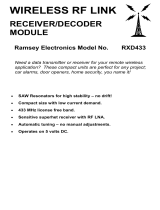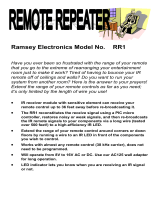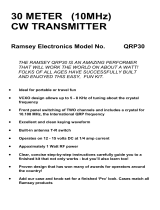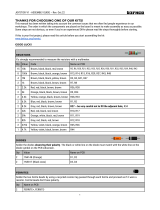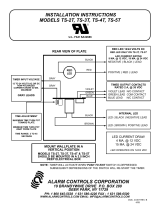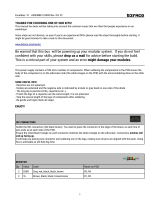Page is loading ...

PPM3 Page 1
Ramsey Electronics Model No. PPM3
Ever wish you could broadcast on-the-air telephone calls like
the commercial radio stations? Well now you can! The PPM3
gives you the ability to broadcast both sides of a phone
conversation without having to change any connections to
return to your music or other programming. Perfect for the
budding talk radio star in your house!
• Operates on 8 to 12 volts DC
• Automatic noise gating
• Automatic variable gain and compression
• Allows both sides of a phone conversation to be broadcast over-
the-air
• Connect your line level audio source to the PPM3 and use the
loop output; no separate mixing board needed
PHONE PATCH
MIXER KIT

PPM3 Page 2
RAMSEY TRANSMITTER KITS
• FM10A, FM25B FM Stereo Transmitters
• FM100B Professional FM Stereo Transmitter
• TXE433 or 916 Transmitter & Encoder Module
• RXD433 or 916 Data Receiver& Decoder
• RR1 Wired remote repeater
• RRW1 Wireless remote repeater
RAMSEY RECEIVER KITS
• FR1 FM Broadcast Receiver
• AR1 Aircraft Band Receiver
• SR1 Short-wave Receiver
RAMSEY HOBBY KITS
•
WEB1 Walking Electronic Bug
• LEDS1 LED Strobe
• BE66 Blinky Eyes
• EDF1 Electronic Dripping Faucet
• TFM3 Tri-Field Meter
• LC1 Inductance-Capacitance Meter
RAMSEY AMATEUR RADIO KITS
• HR Series HF All Mode Receivers
• QRP Series HF CW Transmitters
• CW7 CW Keyer
• DDF1 Doppler Direction Finder
• QRP Power Amplifiers
RAMSEY MINI-KITS
Many other kits are available for hobby, school, Scouts and just plain FUN. New
kits are always under development. Write or call for our free Ramsey catalog.
PPM3 PHONE PATCH MIXER KIT MANUAL
Ramsey Electronics publication No. MPPM3 Revision 1.3
First printing: January 200 GMG
COPYRIGHT 2002 by Ramsey Electronics, Inc. 590 Fishers Station Drive, Victor, New York
14564. All rights reserved. No portion of this publication may be copied or duplicated without the
written permission of Ramsey Electronics, Inc. Printed in the United States of America.

PPM3 Page 3
PHONE PATCH MIXER KIT
Ramsey Publication No. MPPM3
Price $5.00
TABLE OF CONTENTS
Introduction ...........................................4
Theory of Operation ..............................5
Learn As You Build ...............................8
Parts Placement Diagram ...................11
Parts List .............................................12
Schematic Diagram .............................14
Assembly Steps ...................................15
Testing your PPM3 ..............................21
Troubleshooting Guide ........................23
Specifications ......................................25
Warranty ..............................................27
KIT ASSEMBLY
AND INSTRUCTION MANUAL FOR
RAMSEY ELECTRONICS, INC.
590 Fishers Station Drive
Victor, New York 14564
Phone (585) 924-4560
Fax (585) 924-4555
www.ramseykits.com

PPM3 Page 4
PPM3 INTRODUCTION
We’ve all heard those awesome call-in programs on the radio. You know, the
ones where the host lets the average Joe give his opinion on-the-air to all of his
listeners . . . regardless of intelligence level or speaking skills! Yes, we’ve all
been embarrassed for poor old Joe when he puts his foot in his mouth and
we’ve all thought that we could be much more brilliant and interesting than the
high paid host we’re listening to. Well, here’s your opportunity to try your hand
at talk radio on a micro scale. You FM and AM micro or hobby broadcasters
know what fun it is to decide the programming on your house station and be
able to listen to all your favorites out in the yard or garage. And your close
neighbors have been listening too, as you’ve heard over the back fence. Then
there are those of you who use our hobby transmitters at swap meets or flea
markets and hamfests to tell the happy customers how to find the best deals
and where the doughnuts are. We designed the PPM3 to add a whole new
dimension to your transmitting/broadcasting experience. Now you can allow the
locals to call in and voice an opinion and hear it broadcast on your micro
station. Hey, we all know how much people love to hear their own voice on the
radio. They’re probably listening to you already and wondering how come you
get to have all the fun (We know it’s because you’re spending all the time and
money but they didn’t think that far!) . . . now you can let them have some fun
of their own! Have your listeners let you know what they’d like to hear on your
station, let them tell people in your listening area about upcoming events in
their own words, start a new talk radio program to deal with community
issues . . . the possibilities are limited only by your imagination . . . and your
callers diction and phone etiquette. No, you probably won’t become the next
Rush Limbaugh but you can enjoy that “in control” feeling in your own
“broadcast booth” taking those phone calls just like the big boys. Thanks to all
of you who called and emailed to let us know that you wanted a kit like this. We
know you’re going to love using the PPM3 with your hobby broadcast
equipment. Let’s stop talking and start understanding and building your new
Phone Patch Mixer!

PPM3 Page 5
PPM3 CIRCUIT DESCRIPTION
The PPM3 is essentially a stereo audio mixer, with one stereo line input and
two specialized mono inputs, each feeding into the stereo line output. The
phone and mic inputs each have a pre-amp stage that acts as a complete sig-
nal conditioner. The mixing core is done with two op amps, U2:C for the left
channel and U2:D for the right channel.
The line inputs are AC coupled and volume adjusted by R2 and then fed into
the mixer. The maximum voltage gain from the line inputs to the line outputs
for each channel is 3.2, or 10 dB. This is set by the ratio of R22/R23 for the
left channel and R21/R24 for the right channel. The maximum voltage gain
can be calculated for each channel by:
G(left) = R22 / R23 = 15K / 4.7K = 3.2
G(right) = R21 / R24 = 15K / 4.7K = 3.2
If you are interested in the gain in dB format, it can be converted by the follow-
ing:
G(dB) = 20 * Log (G) = 20 * Log (3.2) = 10 dB
These are the maximum gains that are achieved when the line volume pot is
set to its full (clockwise) position.
The microphone input has a DC phantom power of +5V which is required for
some microphones. If not needed, this can be eliminated by not installing
R13. If you’re not sure what your mic needs, install R13. The signal is AC
coupled by C33 before it goes into the pre-amp. A value of 5.6nF was chosen
because with an input impedance for the pre-amp of 180 K, a high-pass filter
is utilized that cuts out frequencies below roughly 150 Hz. In effect, this is
desirable for a vocal microphone because it will eliminate some annoying
“pops” and other low-frequency noise like 60 Hz AC line hum, for example.
U3 is the pre-amp that performs a few useful functions all in one part. First, it
acts as a noise gate which simply means that it effectively “turns off” the mic
when only background noise is present, and then automatically turns back on
when there is a minimum signal. It also acts as a variable compression ampli-
fier, which means that it will amplify a quiet whisper more than it would a loud
shout. Its compression ratio is determined by R9, which with the 39K resistor,
works out to be about a 3.5:1 compression ratio. C6 controls the release time
of the compression and the real-time rms averaging for the internal level de-
tector. This capacitor can range from 2.2uF to 22uF. The 10uF value seemed
to give a good compromise. Too small of a value and the gain will change two
fast, two large a value can result in slow response times to signal dynamics. If
other compression ratios are desired, this chart can be used:

PPM3 Page 6
The microphone pushbutton switch (S3) is used to turn on the mic channel by
pushing it in, and to mute the mic channel by leaving it out. The mic LED is
powered on when the mic is on by using the other half of the switch.
The phone line input is meant to monitor both ends of a phone conversation.
An external local phone connected to the output phone jack is needed to per-
form dialing and to take the phone line “off hook” in order to answer a call.
The phone input can be disconnected from the phone lines and muted by us-
ing the phone pushbutton switch. Like the mic switch, mute is “out” and on is
“in”. The phone signal is filtered for unwanted high frequency noise by C3 and
C4; this is called low-pass filtering (LPF). It is also filtered for unwanted low
frequency noise by C5, which is called high-pass filtering (HPF). This cap is
also used to block the high DC voltage on the phone line from passing through
the isolation transformer, T1. Because of this DC voltage which normally is
50 VDC off-hook, and can even have spikes upwards of hundreds of volts, the
first three caps in the circuit (C3, C4, C5) were chosen to be able to handle 1
kV each. R30 performs some signal attenuation and isolation, and then the
isolation transformer T1 further helps prevent unwanted interference between
the phone line circuit and the PPM3 circuitry. T1 also takes the differential
phone audio signal and converts it to a single-ended signal (which means one
side is grounded). C31 performs some more LPF, and C16 performs some
more HPF. R31 is one more protection against the PPM3 circuit interfering
with the phone line circuits and vise-versa. The two diodes, D1 and D2 pro-
vide a final protection against high-level signals reaching the PPM3 circuitry
and potentially doing damage. They provide an upper voltage limit of 0.7 volts
and a lower voltage limit of –0.7 volts. Any signal outside these limits will be
shorted to ground. At this point, the signal is amplified with the same type of
pre-amp that mic circuit used, but with a different compression level. The
problem with monitoring both sides of a phone conversation is that the signal
from the local phone is usually much higher is amplitude than the signal from

PPM3 Page 7
the far-end phone. So the solution is to use a high amount of compression in
order to amplify the far-end, weaker signal much more than the local stronger
signal. In this way both sides of the conversation are closer to each other in
signal strength when applied to the main mixer. A 100K ohm resistor was
used to set the compression level around 7:1. The same chart that was used
for the mic circuit can also be used with the phone circuit if a different com-
pression ratio is desired.
The clip detect circuit that powers the clip LED is basically constantly com-
paring the signals from both the left and right channels against a set threshold
that is close to the mixer amp’s upper voltage rail, which is where it clips.
There is a little amount of hysteresis to enable the LED to be lit up long
enough to visibly see it during short signal spikes. The core of the peak detect
circuit is D3, D7, R25, and C24. Basically, an averaging DC peak voltage
sample is created, held with a charge on C24, and discharged with R25. R20
and R17 control the charge time of C24.

PPM3 Page 8
RAMSEY “LEARN-AS-YOU-BUILD” ASSEMBLY STRATEGY
Be sure to read through all of the steps, and check the boxes as you go to
be sure you didn't miss any important steps. Although you may be in a hurry
to see results, before you switch on the power check all wiring and
capacitors for proper orientation. Also check the board for any possible
solder shorts, and/or cold solder joints. All of these mistakes could have
detrimental effects to your kit - not to mention your ego!
Kit building tips:
Use a good soldering technique - let your soldering iron tip gently heat the
traces to which you are soldering, heating both wires and pads
simultaneously. Apply the solder to the iron and the pad when the pad is hot
enough to melt the solder. The finished joint should look like a drop of water
on paper, somewhat soaked in.
Mount all electrical parts on the top side of the board provided. To install
parts, the component should be placed flat to the board, and the leads
should be bent on the backside of the board to prevent the part falling out
before soldering (1). The part is then soldered securely to the board (2-4),
and the remaining lead length is clipped off (5). Notice how the solder joint
looks close up, clean and smooth with no holes or sharp points (6).

PPM3 Page 9
Although we know that you are anxious to complete the assembly of your
phone patch mixer kit it is best to follow the step-by-step instructions in this
manual. Try to avoid the urge to jump ahead installing components.
Remember that all of the components will be mounted on the component side
of the circuit board and soldered on the solder side of the circuit board (the side
that contains the printed circuit traces). Have a look at the parts layout diagram
to help with your assembly.
Use the boxes to check off your progress.
Check all received parts against the parts list. The parts list describes the
various markings that may be found on the kit parts. Carefully sort the parts into
small piles to aid in finding the correct part at the required time.
Proper Component Installation:
Surface mount component soldering instructions:
The SMT components will be affixed to the topside of the PC board in the U1
and U3 positions. Patience is the key when installing surface mount
components. Typically, the first step (after identifying the component) is to “tin”
one of the PC traces that will connect to the part. This may go a little “against
the grain” at first, but it is by far the easiest method. Notice also that when
reheating the solder that the iron tip does not come in contact with the “tab” on
the body of the chip component. Over heating of this solder tab can cause a
fracture of the bond to the component causing an intermittent connection.

PPM3 Page 10
Once this is accomplished, the part can be installed by holding it with
tweezers in contact with the “tinned” trace and re-heating the solder (see the
associated diagrams). Another commonly used technique is to glue the
surface mount components to the printed circuit board before soldering. The
procedure is to take a small amount of glue (usually with a pin or toothpick)
and “dab” the circuit board in the place where the component will be affixed.
Be careful not to apply too much glue as when the part is placed it may
“squash” the glue underneath the soldering tabs of the component. Carefully
place the part into position, and when the glue dries, solder the connection.

PPM3 Page 11
PPM3 PARTS PLACEMENT DIAGRAM

PPM3 Page 12
PARTS SUPPLIED WITH YOUR PPM3 KIT
Capacitors
1 2.2nF ceramic disc capacitor [marked 222] (C16)
1 5.6nF ceramic disc capacitor [marked 562] (C33)
3 10nF ceramic disc capacitors [marked 103] (C11,C13,C23)
2 High voltage 10nF capacitors [large red capacitors marked .01M] (C3,
C4)
1 47nF ceramic disc capacitor [marked 473] (C31)
4 0.1uF ceramic disc capacitors [marked 104] (C8,C9,C22,C24)
1 High voltage 0.1uF ceramic disc capacitor [very large orange cap
marked .1M] (C5)
4 1uF electrolytic capacitors [cylindrical body with a stripe or
band, marked 1uF] (C25,C26,C29,C30)
12 10uF electrolytic capacitors [cylindrical body with a stripe or
band, marked 10uF] (C1,C2,C6,C14,C15,C17,C18,C19,C20,C21,
C27,C28)
1 1000uF electrolytic capacitor [cylindrical body with a stripe or
band, marked 1000uF] (C10)
Resistors
1 10k stereo audio pot (R2)
2 10k audio pots (R12,R15)
5 470 ohm resistors [yellow-violet-brown] (R6,R17,R19,R20,R28)
7 4.7k ohm resistors [yellow-violet-red] (R7,R8,R10,R11,R23,R24,R31)
1 5.6k ohm resistor [green-blue-red] (R30)
4 10k ohm resistors [brown-black-orange] (R13,R14,R16,R18)
3 15k ohm resistors [brown-green-orange] (R21,R22,R27)
1 39k ohm resistor [orange-gray-orange] (R9)
1 75k ohm resistor [violet-green-orange] (R26)
1 100k ohm resistor [brown-black-yellow] (R4)
1 220k ohm resistor [red-red-yellow] (R29)
1 1 Meg ohm resistor [brown-black-green] (R25)
Semiconductors and Integrated Circuits
4 1N4148 diodes [orange glass body with black band, marked 4148]
(D1,D2,D3,D7)
1 78L05 voltage regulator [like a transistor marked LM78L05]
(VR1)
1 Green LED (D5)
2 Red LEDs (D4,D6)
1 LMC6484 Quad opamp (U2)

PPM3 Page 13
2 SSM2165-1S surface mount microphone amplifier ICs (U1,U3)
Miscellaneous Components
3 DPDT switches (S1,S2,S3)
1 1/4” stereo jack (J7)
1 Dual RJ11 jack (J1)
1 2.1mm power jack (J4)
2 Dual RCA jacks (J2,J3)
1 Isolation transformer [large yellow part with 6 leads] (T1)
1 Piece of heat shrink tubing

PPM3 Page 14
PPM3 SCHEMATIC DIAGRAM

PPM3 Page 15
PPM3 PHONE PATCH MIXER ASSEMBLY
Assembly of the PPM3 is easy but still requires some time and patience. We
will start with the surface mount parts and get them out of the way.
As with any static sensitive parts be careful when installing the IC’s in this
kit. Don’t rub your feet across the carpet and then grab the chip out of your kit
as it may be damaged. It’s helpful to ground yourself to a metal object before
picking up and installing the next three parts.
1. Install U3, the SSM2165-1S surface mount IC. Be sure you have it
lined up with the silkscreen on the PC board so that the notched or dotted
end of the component is placed correctly. In the case of U3 the notch
points toward C13. The dot or notch indicates pin 1 (the pin beneath the
notch if the notch is to the left) and the rest of the pins are counted by
going around the chip in a counterclockwise direction. Tin one pad and
then line the IC up so that all the other pins are placed over the pads they
will be soldered to. Once the chip is lined up correctly, carefully solder the
pin to the pad that was tinned. Make sure that the rest of the pins are lined
up well before soldering a pin on the opposite side of the chip, then
continue around and solder all the pins. Be careful not to bridge the traces
between two of the legs of the chip.
2. In the same way, install U1. The notch or dot on this chip is placed
toward C30, opposite of U3 that you just installed. Follow the same
method and be sure that the pins line up well before soldering them all
into place.
Whew! That was some work. But the toughest two parts have been placed.
Check over your work to be sure there are no unwanted bridges and that the
pins all look soldered. Now let’s move on to the larger through-hole
components.
3. Install U2, the LM6484AIN IC. Follow the PC board silkscreen and
Parts Layout Diagram for proper orientation of this part. The dot or notch
on one end indicates pin 1. The chip must be placed correctly or it will not
work. Be sure to solder all 14 pins. We’re soldering this part in first so that
you can let the board sit on it to keep the part flush to the PC board.
Simply solder in one corner pin, make sure the others are all through the
board equally, and then solder the other corner pin. Check flatness again,
then you can solder the rest of the pins
4. Install C21, 10uF electrolytic capacitor. Electrolytics are polarized and
must be installed correctly or they tend to explode. You’ll see a marking
on the PC board to indicate the positive lead. On the part itself you’ll see a
band or stripe down one side; this indicates the negative lead. This lead is
typically the shorter of the two leads as well. Be sure to orient the part so
that the positive lead goes in the hole marked with a ’+’ sign, then solder
the part in place.

PPM3 Page 16
5. In the same way install C20, a 10uF electrolytic capacitor, again
checking your polarity before soldering.
6. Install C19 and C18, noting that these are also 10uF electrolytics and
the polarity is exactly opposite to the two parts you just installed. Simply
follow the silkscreen and layout diagram for proper placement.
7. Install R14, 10k ohms (brown-black-orange). Resistors have no polarity
and can be installed in either direction, although your board will look more
uniform if you have all the gold stripes headed in the same direction.
8. Install R6, 470 ohms (yellow-violet-brown).
9. Install C8, 0.1uF capacitor (marked 104). Like resistors, disc caps can
be installed in either direction.
10. Install R17, 470 ohms (yellow-violet-brown).
11. Install D3, 1N4148 diode (orange glass body with black band). The
band indicates the cathode or negative side of the part. Follow the PC
board silkscreen and Part Layout Diagram for correct placement of the
band before soldering the part in place.
12. Install R21, 15k ohms (brown-green-orange).
13. Install R20, 470 ohms (yellow-violet-brown).
14. Install C17, 10uF electrolytic capacitor. Remember to watch the polarity
when installing!
15. Install R13, 10k ohms (brown-black-orange).
16. Install D7, another 1N4148 diode (orange glass body with black band).
Remember to line the black band up with the silkscreen for correct
orientation.
17. Install C24, 0.1uF disc capacitor (marked 104).
18. Install R25, 1 Meg ohms (brown-black-green). 1 meg is 1 million ohms!
Wow!
19. Install C2, 10uF electrolytic capacitor. Follow the silkscreen for polarity.
20. Install VR1, the 78L05 5 volt regulator. Place the flat side as shown on
the silkscreen. This part regulates the incoming voltage down to 5 volts for
the parts that require it, and, along with its associated capacitors, smoothes
out the voltage and “cleans” it up.
21. Install C9, 0.1uF disc capacitor (marked 104).
22. Install R28, 470 ohms (yellow-violet-brown).
23. Install R29, 220k ohms (red-red-yellow).
24. Install R26, 75k ohms (violet-green-orange).

PPM3 Page 17
25. Install R19, 470 ohms (yellow-violet-brown).
26. Install R27, 15k ohms (brown-green-orange).
27. Install C23, 10nF (marked 103).
28. Install C22, 0.1uF capacitor (marked 104).
29. Install R22, the last 15k ohm resistor (brown-green-orange).
30. Install R18, 10k ohms (brown-black-orange).
31. Install R16, 10k ohms (brown-black-orange).
32. Install R7, 4.7k ohms (yellow-violet-red).
33. Install R8, also 4.7k ohms (yellow-violet-red).
34. Install R11, 4.7k ohms (yellow-violet-red).
35. Install R10, another 4.7k ohm resistor (yellow-violet-red).
36. Install R24, 4.7k ohms (guess the color code or look above!!)
37. Install R23, yet another 4.7k ohm resistor (yellow-violet-red).
38. Install C26, the first of the 1uF electrolytics. Don’t confuse these with
the 10uF parts you’ve been installing; they’re marked 1uF right on the side
of the capacitor. They are polarity sensitive just like the others though, so
follow the silkscreen for orientation of the positive lead.
39. Install C29, another 1uF electrolytic capacitor. Polarity!
40. Install C28 and C27, 10uF electrolytics. Again, be sure they’re marked
as 10uF and watch the orientation when installing.
41. Install C25, 1uF electrolytic capacitor. Bet you can guess that I’m
going to tell you to be sure you orient it correctly before soldering! But hey,
being reminded beats a big popping sound when you fire up your kit and a
cap explodes, doesn’t it?
42. Install C5, the honkin’ huge orange capacitor marked .1M and also
1KV. This part can be installed in either direction but please be sure you
seat it down on the board as far as you can without damaging it. If you
don’t then you’ll have trouble getting the top cover on, you’ll call me, and
I’ll say “I told you so”. Let’s avoid all that and get it down on the board
right away, then solder both leads. There are several holes all around this
part so be sure you get the right ones;they are the two larger center holes
within the silkscreen outline of the part.
43. Install C4, one of the large red 0.01uF capacitors (marked .01M).
44. Install C3, the other large red 0.01uF caps (marked .01M).
45. Install R30, a 5.6k ohm resistor (green-blue-red).

PPM3 Page 18
We’ll skip T1 for now and come back to it later.
46. Install C31, 47nF (marked 473).
47. Install D2, 1N4148 diode (orange glass body with a black band).
Orient the black band with the band marked on the silkscreen and PC
board layout.
48. Install D1, the last 1N4148 diode (orange glass body with a black
band). Again, make sure you line up the black band on the part with the
silkscreen marking for the part.
49. Install C1, 10uF electrolytic. Remember to line up the positive lead
correctly.
50. Install R31, 4.7k ohms (yellow-violet-red).
51. Install C16, 2.2nF capacitor (marked 222).
52. Install C30, the last 1uF electrolytic capacitor. Watch the polarity when
installing.
53. Install C11, 10nF (marked 103).
54. Install C6, a 10uF electrolytic capacitor. Follow the silkscreen for
proper orientation (again!).
55. Install R4, 100k ohms (brown-black-yellow).
56. Install C13, 10nF capacitor (marked 103).
57. Install C14, 10uF electrolytic. Don’t worry; I’ll only remind you about
polarity on one more of these parts. But like your parents always said
when they gave you advice as a kid, you’ll thank me later.
58. Install C33, 5.6nF (marked 562).
59. Install R9, 39k ohms (orange-white-orange).
60. Install C15, the last 10uF electrolytic. Oh go ahead, you know you
have to make sure you install it correctly!!
Well, the regular parts and the surface mount parts are in; now we’ll tackle
some of the larger components. Then we’ll be moments away from firing up
your new kit and seeing what it can do. One note on the large parts though.
Be sure you have them seated flat on the PC board and that you thoroughly
solder all connections. You’ll want strong solder joints for good mechanical
connections and if these parts aren’t seated properly they will not be robust
You’ll also have trouble when you put the kit in the case because things won’t
line up. A little care now will save a lot of heartache later. Oh, by the way, I
know that the LEDs are rather small but we saved them for later so they
wouldn’t be flopping around while you flipped the board over and back a
million times during construction. They’re so bright and perky we thought we’d

PPM3 Page 19
save them for last. Ok, that’s not the reason, it just makes sense to do them
after all the big, bulky parts are in.
61. Install C10, the big 1000uF electrolytic capacitor. Ok, one last time, for
real, make sure you get the positive lead and the negative lead oriented
correctly before soldering. This one make a big band when it explodes.
62. Install J4, the 2.1mm power jack. It should fit snugly in the board but
be sure it’s flat before soldering. Make sure you use enough heat on the
ground pin for a solid connection; because of the greater surface area of
the ground connections they always require a bit more heat.
63. Install J3, one of the dual RCA jacks. They have mounting holes for
the plastic tabs that help you line them up correctly but you still need to be
sure they’re seated flush to the board before you solder this jack and the
next one, J2. Don’t be nervous about leaving the soldering iron on the
ground connection a couple of seconds longer than the other two pins. It
won’t hurt anything and it needs more heat.
64. In the same way, install J2, the other dual RCA jack.
65. Install J7, the large 1/4” stereo jack. This is another “be sure it’s flat”
part. Trust me, you really will thank me later.
66. Install J1, the dual RJ11 jack. This part snaps into place so that it is
positioned correctly. Solder all leads.
67. Install T1, the isolation transformer. You’ll see a dot on the PC board
and a dot on the part. Orient the part so that the dots line up and solder all
leads.
68. Install S2, one of the DPDT switches. To get these parts to lay down
flat on the PC board I flipped the board over and let it rest on the higher
parts while placing something under the switch to hold it in place. Then I
soldered one lead, made sure the switch was positioned correctly and
flush to the board, then soldered the rest of the pins.
69. Install S3, another DPDT switch. These guys (there are three of them)
look a little bit like the AT-ATs from Star Wars: The Empire Strikes Back
,
don’t they? Remember those big walkers with the imperials inside
shooting everyone? Ok, never mind. Just solder all six leads in and let’s
move on.
70. Install S1, the last of the cool looking DPDT switches.
71. Install R12, one of the two 10k audio potentiometers, ever after to be
known as pots. Yes, the mechanical connections on these that are
soldered to the ground plane will require a bit more time and heat, within
reason. A soldering gun or blow torch is not the idea; just a few more
seconds of heat with the tip of your pencil-type iron will do.

PPM3 Page 20
72. Install R15, the other 10k audio pot.
73. Install R2, the 10k stereo audio pot.
Now the LEDs. As you may know, LEDs have a polarity just like diodes (they
are diodes, light emitting ones) and must be installed correctly to work. The
diagram below shows the anode (positive) and cathode (negative) pins of an
LED. Your PC board is marked with a little diode symbol that looks like a
triangle. The longer anode lead goes toward the large flat end of the triangle
and the shorter cathode lead goes toward the point. On D5 and D6 the
cathode goes directly to the ground plane on the board so it’s easy to see the
orientation. You’ll want to leave the leads as long as possible so that the LED
can be bent over to poke through the front panel of your kit case.
74. Take the small piece of heat shrink tubing and cut it in half. Take one
half of the tubing and place it over the longer anode lead of the green
LED, D5. Place the LED with the longer, shielded lead toward the outer
edge of the PC board. Bend the leads slightly on the backside of the
board to hold the part in place and solder it in.
75. Take the leftover piece of heat shrink tubing and place it over the
longer lead of one of the red LEDs. This one will be D6. Again, leave the
leads long, make sure the tubed lead is facing the front edge of the PC
board and solder the LED in place.
76. Install D4, the last LED and the last part in your kit. This time the
longer anode lead should be placed in the hole closest to R15. Again,
leave the leads long and solder it in place.
CONGRATULATIONS !
Wow, doing great! Your Phone Patch Mixer kit is now complete! Have a final
look over your work, paying particular attention to the orientation of diodes,
capacitors, and IC’s. Carefully inspect the circuit board for stray leads or open
solder connections, then trim and touch up any that need work. Remember
that any problems you find now can save time and effort after the unit has
been cased up and final assembled.
A
K
/
